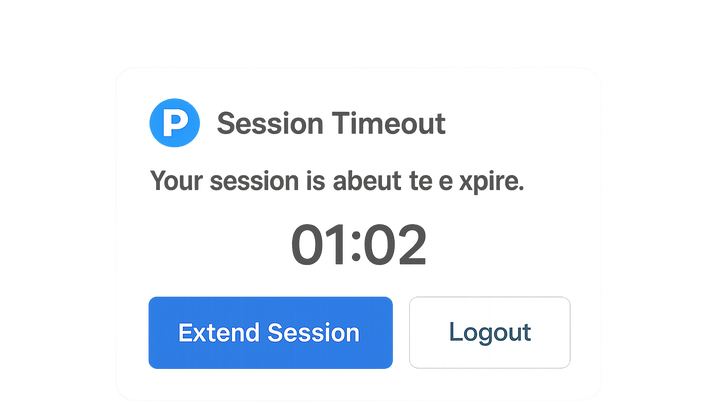Published on 2025-06-29T19:29:16Z
What is Session Timeout? Importance and Best Practices
Session Timeout refers to the automatic termination of a user’s active session on a website or web application after a period of inactivity. This mechanism is essential for maintaining security by preventing unauthorized access if a user leaves a device unattended. However, poorly configured timeouts can harm user experience, leading to lost form inputs, disrupted workflows, and increased cart abandonment, which negatively impacts CRO. From an SEO perspective, session timeouts can influence engagement metrics like bounce rate and time on site, indirectly affecting search rankings. Balancing security, performance, and user experience is key: implementing clear warnings, customizable timeout durations, and seamless session extensions can improve conversions and accessibility. Tools like Prevue.me can analyze and critique these implementations, offering actionable insights to optimize session management for lead generation and overall site performance.
Session timeout
Automatic end of a user session after inactivity; balancing security, UX, and CRO with clear warnings and seamless extensions.
Importance of Session Timeouts in Website Optimization
Session timeouts play a critical role in securing user data, managing server resources, and shaping the overall user experience. They determine how long a session remains active during periods of inactivity. In the context of CRO, they impact conversion flows and cart behavior. For SEO, session management can influence metrics like visit duration and bounce rate. Understanding these factors helps in designing optimal timeout strategies.
-
User experience impact
Unintended session expirations can frustrate users by causing data loss or requiring repeated logins.
- Form data loss:
Users may lose unsaved inputs in forms if a session expires mid-entry.
- Disrupted workflows:
Processes like shopping cart checkouts can be interrupted by timeouts.
- Form data loss:
-
Conversion rate optimization
Properly timed session expirations help maintain user engagement and reduce cart abandonment.
- Cart abandonment:
Long inactivity periods can cause cart resets leading to lost sales.
- Re-engagement opportunities:
Timeout warnings can serve as prompts to re-engage and convert.
- Cart abandonment:
-
Security and compliance
Session timeouts help protect sensitive user data and meet regulatory requirements such as GDPR.
- Data protection:
Automatic logout prevents unauthorized access if a device is left unattended.
- Regulatory standards:
Compliance frameworks often mandate session management policies.
- Data protection:
-
Server performance and resource management
Ending idle sessions frees up server resources and improves overall site performance.
- Resource optimization:
Closing idle connections reduces memory and CPU usage.
- Scalability:
Efficient session handling supports higher concurrent user loads.
- Resource optimization:
Best Practices for Configuring Session Timeouts
Applying best practices to session timeout settings ensures that security needs are met without compromising user engagement. Consider context, user behavior, and accessibility when defining timeout policies.
-
Set contextual timeout durations
Differentiate timeout lengths based on the sensitivity of the session and typical user behavior.
- High-risk actions:
Use shorter timeouts for financial transactions and account settings.
- Low-risk browsing:
Provide longer sessions for informational pages to avoid disruption.
- High-risk actions:
-
Implement warning dialogs
Notify users before timeout with visible countdowns and options to extend.
- Countdown timer:
Display a clear timer at a prominent location.
- Extend session button:
Allow a one-click extension to prevent data loss.
- Countdown timer:
-
Offer seamless session extensions
Allow users to keep their session alive without losing context.
- Auto-refresh mechanisms:
Use AJAX or background requests to refresh sessions silently.
- User consent:
Get explicit permission to extend sessions to align with privacy policies.
- Auto-refresh mechanisms:
-
Respect accessibility and mobile users
Ensure timeout warnings and extensions work across devices and assistive technologies.
- Keyboard navigable:
Design dialogs accessible via keyboard and screen readers.
- Responsive design:
Ensure warning dialogs scale correctly on mobile screens.
- Keyboard navigable:
Common Pitfalls to Avoid
Avoiding these frequent mistakes will help create a smoother and more secure user experience while maximizing conversion opportunities.
-
Lack of warning mechanisms
Users are surprised by abrupt logouts without notice.
- User frustration:
Uninformed logout leads to negative brand perception.
- User frustration:
-
Fixed timeout values
One-size-fits-all timeouts do not account for varied user needs.
- Dynamic adjustment:
Adjust timeout based on user activity patterns.
- Dynamic adjustment:
-
Ignoring session persistence in multi-tab usage
Sessions may expire in one tab while active in another.
- Cross-tab sync:
Use local storage or cookies to sync session states.
- Cross-tab sync:
-
Overlooking analytics and feedback
Failing to monitor session data leads to missed optimization insights.
- Session metrics:
Track average session lengths and abandonment points.
- Session metrics:
Example Implementations and Prevue.me Critiques
Illustrative examples of session timeout setups across different industries and how prevue.me can provide targeted feedback to enhance performance.
-
E-commerce checkout flow
Analysis of checkout session timeouts in an online store.
- Timeout duration:
Recommend 15–20 minute timeout with a 2-minute warning.
- Prevue.me insight:
Highlights if warnings are too late or not prominent enough.
- Timeout duration:
-
Online banking application
Balancing security and UX for financial sessions.
- Timeout policies:
Auto logout after 5 minutes of inactivity to meet security standards.
- Prevue.me insight:
Flags overly aggressive timeouts that hamper customer convenience.
- Timeout policies:
-
Saas dashboard usage
Managing user sessions in analytics or project management tools.
- User roles:
Customize timeouts per role: admins vs viewers.
- Prevue.me insight:
Suggests dynamic extension prompts on high-value pages.
- User roles:
-
Accessibility compliance
Ensuring session timeouts are inclusive.
- Aria live regions:
Use ARIA alerts for timeout dialogs for screen-reader users.
- Prevue.me insight:
Checks for keyboard-only navigation and focus management.
- Aria live regions:
